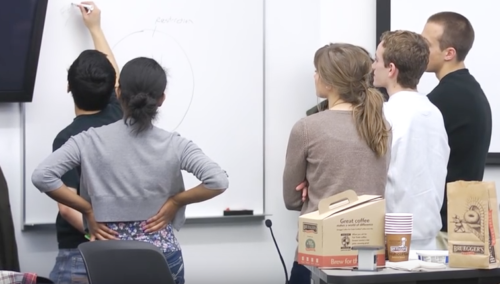September 16, 2019
By Shelley Howell, Ed.D.
If you’ve been teaching for any length of time, you’ve probably heard the term active learning. What do you visualize when you hear active learning? Students raising their hands? Students standing up and moving around? Students responding to instructor questions? Active learning may mean different things to different faculty, especially if those faculty have very different class sizes.
Active learning is basically having students DO something, and then THINK about what they are doing. Movement alone is not active learning. Students must reflect on what they are learning so that they can find their own meaningful connections.

Why is active learning important? Research tells us that students are more engaged and perform better when they are exposed to active learning techniques. The reason is simple: Engaging in an active learning activity breaks up the course session and keeps students from losing interest. It’s also the difference between passively receiving information and actively engaging in the content.
Learning also sticks better for students in classes that incorporate active learning strategies because they actually think about the content you are teaching in a different way. Lectures and exams are useful, but your students will learn better if you incorporate some simple active learning techniques in your class.
To implement active learning techniques in your class, ask students to generate their own questions, connections and solutions instead of giving these to them in a lecture. Consider giving them boundaries, parameters and instructions, and allowing them to find their own answers. Make sure you also give them the opportunity to integrate their new knowledge with their existing knowledge and opportunities to recall and reflect on that knowledge.
Still not sure? Here are 10 ways to incorporate active learning in your class:
1. Think-Pair-Share – Have students find a partner and discuss a problem, question, or concept.
2. Minute Paper – Have students take one minute to reflect on the content. You can ask them to respond to a specific question, or have them write out questions they still have about the content.
3. Polling – Use polling software, a survey, or a show of hands, to ask students to respond to questions about the content. This also gives the faculty a quick way to see if students are getting the concept.
4. Student-Generated Questions – Have students write their own quiz, exam or journal questions.
5. Guided Notes – Provide students with an outline or “skeleton” of your lecture. As you teach, they fill in the missing content.
6. Concept Map – Have students create a mind map or outline of a concept.
7. Group Problem Solving – Group students and give each group a problem to solve that relates to the content.
8. Peer Teaching – Have students teach each other the content.
9. Forced Reflection – Require regular journal entries or minute papers to force students to think about what they are learning.
10. Games – Create a game from your content, or have students create the games.
TLS provides a variety of resources on active learning for UTSA faculty on its web site, you can find them here. For one-on-one help, schedule a consultation with a TLS consultant here.

